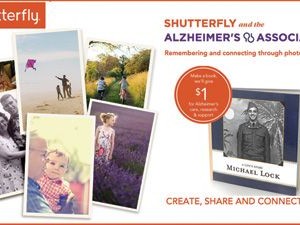
Redwood City, CA—Shutterfly formed a partnership with the Alzheimer’s Association to share the benefits of using photos as reminiscence therapy with people living with Alzheimer’s disease.
In August, aided by the Alzheimer’s Association, Shutterfly launched a resource page that offers “Top Photo Tips for Families Facing Alzheimer’s Disease”; research-guided suggestions on how to use photos with people living with Alzheimer’s; and tips for putting together a meaningful photo book for people with Alzheimer’s and their caregivers (shutterfly.com/alz).
Shutterfly’s support began in June with a $25,000 donation to help fund Alzheimer’s care, support and research programs. Its involvement will continue throughout 2015 with fundraising, social activations, event sponsorship and local participation in Walk to End Alzheimer’s events nationwide. Additionally, for every preselected Shutterfly “family memory” photo book sold during the summer, the company donates $1 to the Alzheimer's Association.
Shutterfly’s long heritage in helping families share life’s joy through photos uniquely positions the company to help the more than five million Americans living with this devastating disease—and their 15 million caregivers.
“Alzheimer’s is a devastating disease that strikes close to home for Shutterfly because it impacts the entire family more than any other disease, including many of our employees’ families,” said Lara Hoyem, general manager of photo books for Shutterfly. “Bringing families together through photos is at the core of what we do at Shutterfly, and we look forward to applying this expertise to help move forward the Alzheimer's Association’s laudable commitment to eradicate this awful disease.”
The therapeutic tips below, compiled by the Alzheimer’s Association in partnership with Shutterfly, include practical guidance for engaging those with Alzheimer’s and using photos as tangible prompts for conversation.
• Place photos in chronological order. Photo books can be great tools for showing someone’s life history. Start a photo book at the beginning of the person’s life and lead up to the present. Organize the book around key moments and concentrate on happy occasions to assist with engagement. Keep the design simple, with one or two pictures per page, so the photos are easy to focus on.
• Show relationships. To help spark recognition of family members, dedicate a section to each person. Choose photos that include the person with the family member from different life stages and place them in chronological order.
• Select meaningful moments. Be sure to include photos that reflect the person’s meaningful life moments and depict his/her favorite hobbies or activities, such as weddings, graduations and vacations.
• Make it an activity. Work with the individual as appropriate to create the book, and share memories and conversation as you put it together.
• Engage in conversation. Ask open-ended questions about the people or events in the photo. “How were you feeling in that picture?” “Tell me about your brother.” “What are some of your favorite childhood stories?” The answers are less important than the conversation and engagement.
• Share your own memories. As part of the conversation, share your memories and feelings when looking at the pictures. Answer some of the same questions you’re asking the person with Alzheimer’s.
• Connect, don’t correct. This is more about making a connection and sharing memories. Focus on connecting with the person, not correcting them.
• Revisit frequently. Take the time to frequently revisit memories using the photos. Do what works best for the individual. It may be daily or weekly, depending on the person.
• Mix it up. Don’t discuss the same set of photos week after week. To help keep it fresh and interesting, discuss various parts of the book with different people and events on a regular basis.
• Move at a comfortable pace. Follow cues from the individual to gage their interest level and determine how much time to spend per photo. Spend more time on the ones that spark interest or conversation and move on if they do not.
“Alzheimer’s is the only leading cause of death in the top 10 with no way to treat or slow it. This Shutterfly partnership will help to both raise awareness about ways to connect with individuals living with Alzheimer’s while also supporting cutting-edge research and the families and caregivers grappling with the disease,” added Beth Kallmyer, vice president, Constituent Services, Alzheimer’s Association. “We’re excited about Shutterfly’s willingness to package their expertise in family photos with the expertise of the Alzheimer’s Association in working with people with the disease and families.” alz.org and shutterflyinc.com





